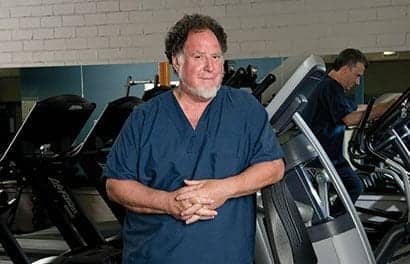
Dennis Hwang, MD
The Fontana Medical Center, part of the Kaiser Permanente health care system, provides care for over 400,000 members in the Southern California area. This integrated managed care system emphasizes the cost-efficient delivery of medical care and outcomes-based medicine through a focus on preventative care and strict control of chronic diseases. This emphasis has influenced the evolution of sleep medicine within Kaiser Permanente, which was an early adopter of the potentially more cost-effective home sleep testing (HST); this has become our primary testing modality for obstructive sleep apnea (OSA). Over the past 3 years, our sleep center has focused on fine-tuning the sleep center delivery of care model specific to Fontana Medical Center and improving clinical outcomes by emphasizing the management of sleep disorders after diagnosis. We believe that this model has improved the quality of care for our patients and reduced the burden on our primary care physicians, and we hope it may eventually prove to reduce disease burden and health care utilization.
The sleep department began several years ago as an attended polysomnography testing facility. As this service could no longer meet the growing referral demands, HST was introduced rather than further expanding the in-laboratory facility. The sleep center, however, functionally remained a laboratory that provided testing but still lacked services to provide clinical follow-up. The follow-up process and trouble-shooting were primarily shared between the primary care provider and durable medical equipment (DME) company, and patients often found themselves being passed back and forth between the different providers. This resulted in disjointed care and significant frustration among patients and among primary care physicians who lacked the setup to adequately follow up CPAP use. As a result, patient adherence to CPAP, defined as at least 4 hours of use on 70% of nights (Medicare definition), was estimated at 20% to 30% and patients frequently did not know basic CPAP care such as the need to replace masks at regular intervals. At the Fontana Medical Center, the primary care-based model of managing OSA proved to be ineffective.
In 2009, the sleep department transformed into a comprehensive sleep center that internalized the follow-up management of OSA and other sleep disorders through the development of several programs, such as a CPAP follow-up program. This relieved the burden of managing these patients from the primary care physicians and DME provider, and the feedback from both patients and primary care physicians has been exceptionally positive.
As programs within the model continue to be developed, we assess their effectiveness and efficiency in delivering care, and our clinical protocols undergo frequent adjustments. In effect, each developed program becomes a quality improvement project assessing the model’s treatment efficacy, cost-efficiency of care delivery, and effect on disease burden and health care utilization. In combination with comprehensive electronic health records, a system is in place to continually address these important areas.
PATIENT CARE MODEL
Our primary challenge in our delivery of care is the extremely high volume of patients referred for evaluation. With upwards of 900 referrals per month, the care ultimately shouldered by two full-time sleep physicians, we have utilized three strategies to create efficiency: 1) Use of support staff (physician assistant, nurse, and respiratory therapist) to provide patient case management; 2) Utilizing group formats when appropriate; 3) Incorporating technology. Each of these components will be evident as our model is described (Figure 1).

Figure 1. Sleep center workflow.
Home Sleep Testing for OSA
Most patients with suspected OSA are tested through our ambulatory HST pathway. The majority are enrolled in an OSA class where sleep apnea education is provided and a 1-night portable monitor (Embletta, Natus) is set up. During the individual return appointment the next day, the portable monitor (PM) study is auto-scored and validated by a case manager. If indicated, the patient is individually educated on use of an autoCPAP (APAP) and sent home with a 1-week trial. During this trial, the APAP is analyzed via wireless modem and trouble-shooting is performed if necessary. Patient clinical history, results of testing, and feedback information are reviewed by a sleep physician and recommendations are implemented by the case manager.
For patients who live extensive distances from the primary sleep center, an alternative Remote Ambulatory Program was developed. In this model, primary care clinic nurses apply a sleep questionnaire and a simple-to-use PM, and the study data are uploaded to an Internet-based server from which the sleep physician can provide an interpretation remotely. If an APAP trial is indicated, the patient is scheduled for a group CPAP class where OSA education and APAP setup are performed by sleep center case managers who travel weekly to the remote location.
Our sleep center performs 70 diagnostic PM studies per week in order to meet our referral demand. While a head-to-head assessment of outcomes comparing the HST pathway versus the attended polysomnography pathway is not feasible, our anecdotal assessment of CPAP compliance suggests favorability toward HST. Inherent advantages of HST include extended CPAP trials for the assessment of optimal CPAP pressure, which allows for a period of acclimatizing, improved patient confidence in their decision whether to use CPAP as long-term therapy, and assessment of night-to-night variability of sleep-disordered breathing including pressure requirements. Finally, without the inherent efficiency of PM testing, a dramatic increase in number of in-lab polysomnography beds would be necessary at very high costs to meet the demands of our patient volume.
CPAP Follow-Up Program
While the high patient volume creates a logistical challenge in the diagnostic process, creating an efficient follow-up model is the more difficult problem to overcome. Although we anticipated that emphasizing more frequent and earlier follow-up after initiation of CPAP would improve adherence, an excessive number of available appointments would be needed to accommodate the 250 CPAP units ordered each month. For example, a protocol that requires three follow-up office visits during the first 3 months would require 750 monthly appointments. In response, we created a respiratory therapist-based structured CPAP follow-up program that took advantage of both technology and group formats. This protocol requires follow-up visits only at month 1 (individual) and month 3 (group). Patients noncompliant at month 1 are given a wireless modem and additional trouble-shooting is provided as needed.
Early internal assessment of the structured follow-up program has shown that it has had a positive impact on patient compliance and return visit show rates. One year CPAP adherence data are pending along with assessment of disease burden and health care utilization compared to degree of CPAP compliance.
In addition to the structured follow-up, other programs were created to support patients on CPAP. A case manager-based CPAP Walk-in Clinic is held weekly, available to all patients with equipment-related issues. A DME closet allows for direct dispensing of CPAP-related equipment. Finally, case managers each hold their own clinic and offer individual office visit appointments to patients in need of additional CPAP trouble-shooting and desensitization sessions. These programs are crucial to successfully internalizing the follow-up management of OSA patients in the following ways: 1) They provide an avenue for patients to obtain care with unscheduled visits while minimizing the disruption to the usual sleep center workflow by limiting available “walk-in” times. 2) They improve patient convenience by limiting their need to have additional visits to the DME provider and primary care physician. The patients understand that the sleep center is the one place to go for their sleep apnea care without having to juggle different providers in different locations.

Figure 2. Reasons for attended PSG.
Additional Sleep-Disordered Breathing Programs
Despite best efforts to maximize adherence to CPAP, it is clear that other therapy options are necessary. Patients unable to comply with CPAP therapy may be offered the Alternative Therapy Program that begins with a consultation with a case manager. While Provent sleep apnea therapy and oral appliance therapy are the two primary alternative therapies that are used, patients are offered these therapies only after ruling out positional therapy as an option and after additional CPAP trouble-shooting. A scripted review of the advantages and disadvantages of Provent and oral appliance therapy is discussed with the patient to facilitate their decision on which therapy to trial. Our challenge regarding alternative therapies is in guiding patients to the therapy more likely to be effective given their sleep apnea phenotype. Patients who elect for a trial of oral appliance therapy are usually given a prefabricated device, and improvement in OSA is assessed before proceeding with a dental referral for a custom appliance.
Because most patients with suspected OSA are evaluated through the ambulatory pathway, attended polysomnography is reserved for those with special conditions (Figure 2). Unlike traditional sleep laboratories, evaluation of complex sleep disorders makes up the majority of the studies with relatively few performed for OSA. Two specialty case managers with polysomnography experience comprise our Complex Sleep Disorders Program and assist in the follow-up management of patients with complex patients seen in the physician clinic.
Sleep Physician Responsibilities
The use of case managers has been necessary to manage the volume of patients, and they function autonomously within a defined scope of practice while their care is protocol driven. However, constant education of the support staff by sleep physicians is critical to maintain the quality of care. Ultimately, reviewing and ordering additional care for each patient remains the responsibility of the sleep physician. Because case managers provide the direct care of OSA and insomnia, this allows the sleep physician clinic to focus on hypersomnia, parasomnias, respiratory failure, and other complex sleep disorders.
FUTURE DIRECTIONS
We intend to continue exploring methods of delivering care, such as improving peri-operative management of patients undergoing bariatric surgery and developing a clinical algorithm for prenatal women at risk for OSA. Technology is constantly evaluated as a possible mechanism to improve quality and efficiency. We also are preparing to study the effectiveness of Web-based interactive programs (Emmi Solutions) to enhance patient education regarding OSA and CPAP. Furthermore, interactive voice recognition programs can be used to provide automated telephone follow-up and assist in prioritizing follow-up of patients on CPAP or with insomnia.
Current challenges in the field of sleep medicine have centered on incorporating HST and optimizing the management of sleep disorders after diagnosis. Our delivery of care model has evolved to naturally address these challenges and will continue to change as new challenges arise.
Dennis Hwang, MD, is medical director of the Sleep Medicine Department at the Kaiser Permanente Fontana Medical Center and co-chair of sleep medicine for the Southern California Permanente Medical Group. He is also faculty at the NYU School of Medicine, Department of Pulmonary, Critical Care, and Sleep Medicine. Questions for the author can be sent to [email protected].
REFERENCES
- Smith B, Phillips BA. Truckers drive their own assessment for obstructive sleep apnea: a collaborative approach to online self-assessment for obstructive sleep apnea. J Clin Sleep Med. 2011;7(3):241-5.
- Pack AI. Sleep medicine: strategies for change. J Clin Sleep Med. 2011;7(6):577-9.
- Kotter JP. Leading change—why transformation efforts fail. Harvard Business Review. 2007;1:1–9.
- Collop N, Fleishman SA. The future of sleep medicine: will you be a part of it? J Clin Sleep Med. 2011;7(6):581-2.




